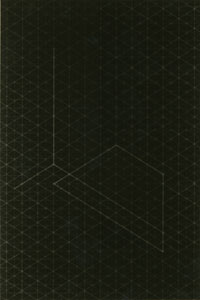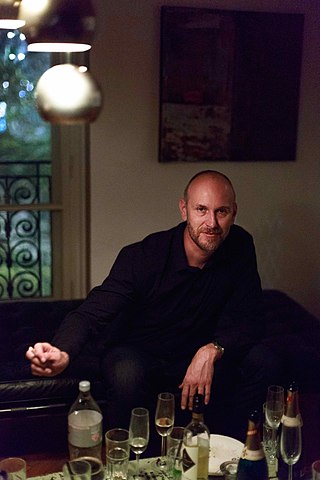Related Research Articles

Peter Weibel was an Austrian post-conceptual artist, curator, and new media theoretician. He started out in 1964 as a visual poet, then later moved from the page to the screen within the sense of post-structuralist methodology. His work includes virtual reality and other digital art forms. From 1999 he was the director of the ZKM Center for Art and Media Karlsruhe.

The Neue Galerie New York is a museum of early twentieth-century German and Austrian art and design located in the William Starr Miller House at 86th Street and Fifth Avenue in New York City. Established in 2001, it is one of the most recent additions to New York City's famed Museum Mile, which runs from 83rd to 105th streets on Fifth Avenue in the Upper East Side of Manhattan.

Angela Bulloch, is a Canadian artist who often works with sound and installation; she is recognised as one of the Young British Artists. Bulloch lives and works in Berlin.
Lothar Hempel is a German artist based in Berlin. He attended Kunstakademie Düsseldorf from 1987 to 1992.
Andy Hope 1930 is a German artist.
Bethan Huws is a Welsh multi-media artist whose work explores place, identity, and translation, often using architecture and text. Her work has been described as "delicate, unobtrusive interventions into architectural spaces".

Fred Sandback was an American minimalist conceptual-based sculptor known for his yarn sculptures, drawings, and prints. His estate is represented by David Zwirner.
Klaus Peter Brehmer, was a German painter, graphic artist and filmmaker. From 1971 to 1997 he was professor at the Hochschule für bildende Künste Hamburg.

Daniel Birnbaum is a Swedish art curator and an art critic. Since 2019, he has been director and curator of Acute Art in London, UK.
Contemporary African art is commonly understood to be art made by artists in Africa and the African diaspora in the post-independence era. However, there are about as many understandings of contemporary African art as there are curators, scholars and artists working in that field. All three terms of this "wide-reaching non-category [sic]" are problematic in themselves: What exactly is "contemporary", what makes art "African", and when are we talking about art and not any other kind of creative expression?
Thea Djordjadze is a contemporary German-Georgian artist based in Berlin, Germany. She is best known for sculpture and installation art, but also works in a variety of other media.
Dennis Rudolph is a conceptual artist working primarily in augmented reality, virtual reality and painting. His artistic practice derives its primal momentum from a melancholic reworking of the heritage of western culture.
Pola Sieverding is a German photographer and video artist. She works in the field of lens based media.
Jonny Star is a German artist. Until 2011 she worked as an artist under her given name Gabriele-Maria Scheda. She lives and works in Berlin and in New York City, United States
Kathy Rae Huffman is an American curator, writer, producer, researcher, lecturer and expert for video and media art. Since the early 1980s, Huffman is said to have helped establish video and new media art, online and interactive art, installation and performance art in the visual arts world. She has curated, written about, and coordinated events for numerous international art institutes, consulted and juried for festivals and alternative arts organisations. Huffman not only introduced video and digital computer art to museum exhibitions, she also pioneered tirelessly to bring television channels and video artists together, in order to show video artworks on TV. From the early 1990s until 2014, Huffman was based in Europe, and embraced early net art and interactive online environments, a curatorial practice that continues. In 1997, she co-founded the Faces mailing list and online community for women working with art, gender and technology. Till today, Huffman is working in the US, in Canada and in Europe.

Rachel Rossin is a multi-media and installation artist based in New York City.

Gretta Louw is a multi-disciplinary artist who has worked with artforms as varied as digital media and networked performance, installation and video art, and fibre art. She lives and works in Germany and Australia. Her artistic practice explores the potential of art as a means of investigating psychological phenomena, particularly in relation to new technologies and the internet. Her focus is on how new digital technologies are shaping contemporary experience.

Christopher Winter is an English contemporary artist. In addition to painting and drawing, both abstract and figurative, Winter also makes video and sculpture. His work interprets contemporary reality and reactions to modern life.

Jay Gard is a German artist. He lives and works in Berlin.
References
- ↑ peer to space
- ↑ House of Electronic Arts Basel(CH)
- ↑ Radiance
- ↑ SALOON
- ↑ see interview with Daniel Durning, Clocktower Radio, New York, 2016
- ↑ see Interview with Tina Sauerlaender on ART&FEMINISM, Berlin Art Link, 2015
- ↑ exhibition TOUCHING FROM A DISTANCE II
- ↑ "Speculative Cultures: A Virtual Reality Exhibition"
- ↑ exhibition Pendoran Vinci
- ↑ exhibition eep Water Cultures
- ↑ exhibition Reset III and Virtual Reality
- ↑ exhibition Uncanny Conditions
- ↑ exhibition The Unframed World
- ↑ exhibition Layered Landscapes
- ↑ exhibition Sometimes You See Your City Differently
- ↑ exhibition When the Cat's Away, Abstraction
- ↑ exhibition Share Your Teeth (With the Ones You Love)
- ↑ exhibition PORN TO PIZZA — Domestic Clichés
- ↑ exhibition SALOON
- ↑ exhibition Dark Sides of...
- ↑ exhibition Divided and Reunified
- ↑ exhibition Money Works Part 2
- ↑ online exhibition Mermaids & Unicorns